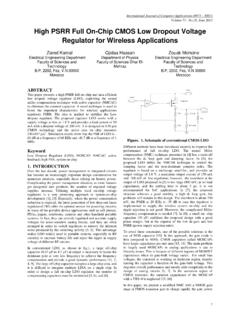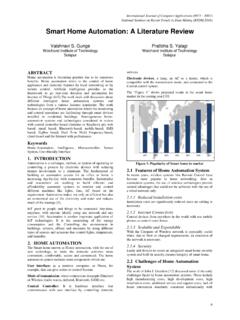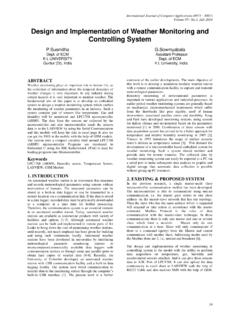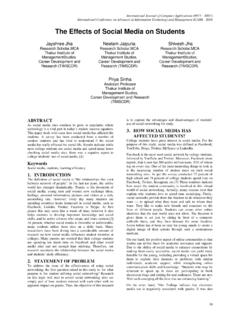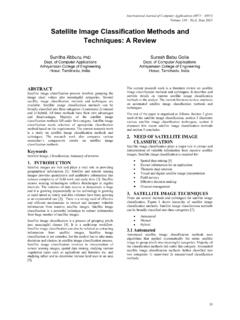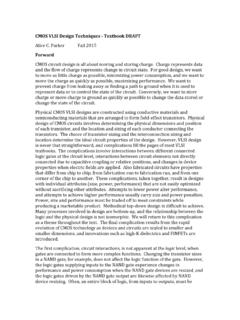Transcription of Leakage Power Reduction in CMOS VLSI Circuits
1 International Journal of Computer Applications (0975 8887) Volume 55 , October 2012 42 Leakage Power Reduction in cmos vlsi Circuits Pushpa Saini Student, Department of Electronics and Communication Engineering NITTTR, Chandigarh Rajesh Mehra Associate Professor, Department of Electronics and Communication Engineering NITTTR, Chandigarh ABSTRACT Leakage Power has become a serious concern in nanometer cmos technologies. In the past, the dynamic Power has dominated the total Power dissipation of cmos devices. However, with the continuous trend of technology scaling, Leakage Power is becoming a main contributor to Power consumption. In the past many methods had been proposed for Leakage Power Reduction like forced stack, sleepy stack, sleepy keeper, dual sleep approach etc. using techniques like transistor sizing, multi-Vth, dual-Vth, stacking transistors etc.
2 In this paper, new methods have been proposed for the Leakage Power Reduction in 90nm technology. The proposed methods will be compared with the previous existing Leakage Reduction techniques. The result is simulated using Microwind in 90nm cmos technology at room temperature. Keywords Leakage Power , Dynamic Power , Multi-threshold, Transistor stacking, Variable body biasing 1. INTRODUCTION The development of digital integrated Circuits is challenged by higher Power consumption. The combination of higher clock speeds, greater functional integration, and smaller process geometries has contributed to significant growth in Power density. Scaling improves transistor density and functionality on a chip. Scaling helps to increase speed and frequency of operation and hence higher performance. As voltages scale downward with the geometries, threshold voltages must also decrease to gain the performance advantages of the new technology, but Leakage current increases exponentially.
3 Thinner gate oxides have led to an increase in gate Leakage current. Today Leakage Power has become an increasingly important issue in processor hardware and software design. With the main component of Leakage , the sub-threshold current, exponentially increasing with decreasing device dimensions, Leakage commands an ever increasing share in the processor Power consumption. In 65 nm and below technologies, Leakage accounts for 30-40% of processor Power . According to the International Technology Roadmap for Semiconductors (ITRS), Leakage Power dissipation may eventually dominate total Power consumption as technology feature sizes shrink. While there are several process technology and circuit-level solutions to reduce Leakage in processors, in this paper several novel approaches for reducing both Leakage and dynamic Power with minimum possible area and delay trade off are proposed.
4 For the most recent cmos feature sizes ( , 90nm and 65nm), Leakage Power dissipation has become an overriding concern for vlsi circuit designers Power consumption of cmos consists of dynamic and static components. Dynamic Power is consumed when transistors are switching, and static Power is consumed regardless of transistor switching. Dynamic Power consumption was previously (at technology and above) the single largest concern for low- Power chip designers since dynamic Power accounted for 90% or more of the total chip Power . Therefore, many previously proposed techniques, such as voltage and frequency scaling, focused on dynamic Power Reduction . However, as the feature size shrinks, , to and , static Power has become a great challenge for current and future technologies.
5 Technology scaling is one of the driving forces behind the tremendous improvement in performance, functionality, and Power in integrated Circuits over the past several years. Power dissipation has become a very critical design metric with miniaturization and the growing trend towards wireless communication. For deep-submicron processes, supply voltages and threshold voltages for MOS transistors are greatly reduced. This to an extent reduces the dynamic (switching) Power dissipation. However, the subthreshold Leakage current increases exponentially thereby increasing static Power dissipation [1]. Leakage current is the current that flows through a transistor when it is switched off. It depends on gate length, oxide thickness and varies exponentially with threshold voltage, temperature and other parameters.
6 Modern digital Circuits consist of logic gates implemented in the complementary metal oxide semiconductor ( cmos ) technology. Power consumption has two components: Dynamic Power and Leakage Power [2]. The dynamic Power is consumed only when the circuit performs a function and signals change. Leakage or static Power is consumed all the time, , even when the circuit is idle. It is unnecessary and one would like to eliminate it [3]. Scaling and Power Reduction trends in future technologies will cause subthreshold Leakage currents to become an increasingly large component of total Power dissipation. Leakage Power mainly depends upon subthreshold Leakage current, which increases with the decrease in threshold voltage. To reduce Leakage Power , several techniques have been proposed, including transistor sizing, multi-Vth, dual-Vth, optimal standby input vector selection, stacking transistors, dual Vdd, etc.
7 2. Power DISSIPATION FACTORS In cmos , Power consumption consists of Leakage Power and dynamic Power Dynamic Power includes both switching Power and short circuit Power . Switching Power is consumed when the transistors are in active mode and short circuit Power is consume when a pull-up and pull-down network are International Journal of Computer Applications (0975 8887) Volume 55 , October 2012 43 on turning on and off. For and above Leakage Power is small compared to dynamic Power but, and below Leakage Power is dominant. Dynamic Power dissipation is proportional to the square of the supply voltage. In deep sub-micron processes, supply voltages and threshold voltages for MOS transistors are greatly reduced. This, to an extent, reduces the dynamic Power dissipation [4]. Static Power dissipation is the Power dissipation due to Leakage currents which flow through a transistor when no transactions occur and the transistor is in a steady state.
8 Leakage Power depends on gate length and oxide thickness. It varies exponentially with threshold voltage and other parameters. Reduction of supply voltages and threshold voltages for MOS transistors, which helps to reduce dynamic Power dissipation, becomes disadvantageous in this case. The subthreshold Leakage current increases exponentially, thereby increasing static Power dissipation. The Leakage current of a transistor is mainly the result of reverse biased PN junction Leakage and Sub threshold Leakage . Compared to the subthreshold Leakage , the reverse bias PN junction Leakage can be ignored. The Subthreshold conduction or the subthreshold Leakage or the subthreshold drain current is the current that flows between the source and drain of a MOSFET when the transistor is in subthreshold region, or weak-inversion region, that is, for gate-to-source voltages below the threshold voltage.
9 [5]. It is given by: ( )( ( )) (1) (2) where 0 is the zero bias electron mobility, n is the subthreshold slope coefficient, Vgs and Vds are the gate to source voltage and drain-to-source voltage, respectively, VT is the thermal voltage, Vth is the threshold voltage, Cox is the oxide capacitance per unit area, and Weff and Leff are the effective channel width and length, respectively. Due to the exponential relation between Vth and Isub, an increase in Vth sharply reduces the subthreshold current. 3. Leakage CURRENT Reduction Reduction in threshold voltage results in the increase in sub-threshold Leakage current. One of challenge with technology scaling is the rapid increase in subthreshold Leakage Power due to Vt Reduction . In such a system it becomes crucial to identify techniques to reduce this Leakage Power component.
10 The development of digital integrated Circuits is challenged by higher Power consumption [6]. Leakage current is a primary concern for low- Power , high-performance digital cmos Circuits . The exponential increase in the Leakage component of the total chip Power can be attributed to threshold voltage scaling, which is essential to maintain high performance in active mode, since supply voltages are scaled. Numerous design techniques have been proposed to reduce standby Leakage in digital Circuits . Leakage Power has become a serious concern in nanometer cmos technologies, and Power -gating has shown to offer a viable solution to the problem with a small penalty in performance [7]. Devices which are operated on battery are either idle (Standby) or Active mode.
